Kristine Hughes's Blog, page 120
September 17, 2012
Queen Victoria in the Highlands
 From Leaves From the Journal of Our Life in the Highlands: From 1848 to 1861 by Arthur Helps
From Leaves From the Journal of Our Life in the Highlands: From 1848 to 1861 by Arthur HelpsSeptember 18, 1858.
Alas! the last day! When we got up the weather seemed very hopeless. Everything was white with snow, which lay, at least, an inch on the ground, and it continued snowing heavily, as it had done since five this morning. I wished we might be snowed up, and unable to move. How happy I should have been could it have been so! It continued snowing till half-past ten or eleven, and then it began to clear up. The hills appeared quite white; the sun came out, and it became splendidly bright. Albert was going to have the woods driven—which are not properly called Carrop Woods, but Garmaddie Woods—but had first to ride round Craig Gowan with Dr. Robertson to see Robrech, the place where Duncan's new house is to be built, which is above the village, opposite Craig Luraghain, with a most splendid view; and at Grant's house I was to meet him.At one o'clock I left with Alice and Lenchen (Princess Helena) for Grant's, where we met Albert, who joined us in the carriage: the day was truly splendid. We got out at the river, and were going down to Nelly's Bush, when a stag was heard roaring very near; so we had to stop, and, with our plaids and cloaks to sit upon, really avoided getting very wet. We waited till Albert was near to the stag, saw it move, heard Albert fire twice, and the stag turn, stop, and then disappear. Albert fired again, but the stag had crossed the Dee; so we turned up on to the road, and went into the dear old Corrie Bute; Albert turning off to see if there were any deer near, while we waited for him. We then came to a place which is always wet, but which was particularly bad after the late rain and snow. There was no pony for me to get on; and as I wished not to get my feet wet by walking through the long grass, Albert proposed I should be carried over in a plaid; and Lenchen was first carried over; but it was held too low, and her feet dangled; so Albert suggested the plaid should be put round the men's shoulders, and that I should sit upon it; Brown and Duncan, the two strongest and handiest, were the two who undertook it, and I sat safely enough with an arm on each man's shoulder, and was carried successfully over. All the Highlanders are so amusing, and really pleasant and instructive to talk to—women as well as men—and the latter so gentlemanlike. Albert's shots were heard close by whilst we were at luncheon; and there was a general rush of all the people. Albert joined us soon after; he had had a great deal of trouble in stalking his stag, which he had been after several days, but had killed him at one shot. He was brought for us to see: a very light-coloured one, with fine straight horns, of extraordinary thickness. After this we walked on for a beat quite round Carrop; and the view was glorious! A little shower of snow had fallen, but was succeeded by brilliant sunshine. The hills covered with snow, the golden birch-trees on the lower brown hills, and the bright afternoon sky, were indescribably beautiful. . . . [image error]
Published on September 17, 2012 22:32
September 15, 2012
Trading in Death - Wellington
Link to book
Household Words
Charles Dickens
Saturday, November 27th 1852
(The Duke died on 14 September 1852; his State Funeral took place on November 18)
Several years have now elapsed since it began to be clear to the comprehension of most rational men, that the English people had fallen into a condition much to be regretted, in respect of their Funeral customs. A system of barbarous show and expense was found to have gradually erected itself above the grave, which, while it could possibly do no honor to the memory of the dead, did great dishonor to the living, as inducing them to associate the most solemn of human occasions with unmeaning mummeries, dishonest debt, profuse waste, and bad example in an utter oblivion of responsibility. The more the subject was examined, and the lower the investigation was carried, the more monstrous (as was natural) these usages appeared to be, both in themselves and in their consequences. No class of society escaped. The competition among the middle classes for superior gentility in Funerals—the gentility being estimated by the amount of ghastly folly in which the undertaker was permitted to run riot—descended even to the very poor : to whom the cost of funeral customs was so ruinous and so disproportionate to their means, that they formed Clubs among themselves to defray such charges. Many of these Clubs, conducted by designing villains who preyed upon the general infirmity, cheated and wronged the poor, most cruelly ; others, by presenting a new class of temptations to the wickedest natures among tiiem, led to a new class of mercenary murders, so abominable in their iniquity, that language cannot stigmatize them with sufficient severity. That nothing might be wanting to complete the general depravity, hollowness, and falsehood, of this state of things, the absurd fact came to light, that innumerable harpies assumed the titles of furnishers of Funerals, who possessed no Funeral furniture whatever, but who formed a long file of middlemen between the chief m'.vuner aud the real tradesman, and who hired out the trappings from one to another —passing them on like water-buckets at a fire —every one of them charging his enormous percentage on his share of the " black job." Add to all this, the demonstration, by the simplest and plainest practical science, of the terrible consequences to the living, inevitably resulting from the practice of burying the dead in the midst of crowded towns ; and the exposition of a system of indecent horror, revolting to our nature and disgraceful to our age and nation, arising out of the confined limits of such burial-grounds, and the avarice of their proprietors; and the culminating point of this gigantic mockery is at last arrived at.
Out of such almost incredible degradation, saving that the proof of it is too easy, we are still very slowly and feebly emerging. There are now, we confidently hope, among the middle classes, many, who having made themselves acquainted with these evils through the parliamentary papers in which they are described, would be moved by no human consideration to perpetuate the old bad example ; but who will leave it as their solemn injunction on their nearest and dearest survivors, that they shall not, in their death, be made the instruments of infecting, either the minds or the bodies of their fellow-creatures. Among persons of note, such examples have not oeen wanting. The late Duke of Sussex did a national service when he desired to be laid, in the equality of death, in the cemetery of Kensal Green, and not with the pageantry of a State Funeral in the Boyal vault at Windsor. Sir Robert Peel requested to be buried at Drayton. The late Queen Dowager left a pattern to every rank in these touching and admirable words. " I die in all humility, knowing well that we are all alike before the Throne of God; and I request, therefore, that my mortal remains be conveyed to the grave without any pomp or state. They are to be removed to St. George's Chapel, Windsor, where I request to have as private and quiet a funeral as possible. I particularly desire not to be laid out in state. I die in peace and wish to be carried to the tomb in peace, and free from the vanities and pomp of this world I request not to be dissected or embalmed, and desire to give as little trouble as possible."
With such precedents and such facts fresh in the general knowledge, and at this transition time in so serious a chapter of our social history, the obsolete custom of a State Funeral has been revived, in miscalled "honor" of the late Duke of Wellington. To whose glorious memory be all true honor while England lasts!
We earnestly submit to our readers that there is, and that there can be, no kind of honor in such a revival; that the more truly great the man, the more truly little the ceremony ; and that it has been, from first to last, a pernicious instance and encouragement of the demoralising practice of trading in Death.
It is within the knowledge of the whole public, of all diversities of political opinion, whether or no any of the Powers that be, have traded in this Death—have saved it up, and petted it, and made the most of it, and reluctantly let it go. On that aspect of the question we offer no further remark.
But, of the general trading spirit which, in its inherent emptiness ana want of consistency and reality, the long-deferred State Funeral has appropriately awakened, we will proceed to furnish a few instances all faithfully copied from the advertising columns of The Times.
First, of seats and refreshments. Passing over that desirable first-floor where a party could be accommodated with " the use of a piano"; and merely glancing at the decorous daily announcement of "The Duke of Wellington Funeral Wine," which was in such high demand that immediate orders were necessary; and also " The Duke of Wellington Funeral Cake," which " delicious article could only be had of such a baker ; and likewise " The Funeral Life Preserver," which could only be had of such a tailor ; and further " the celebrated lemon biscuits," at one and fourpence per pound, which were considered by the manufacturer as the only infallible assuagers of the national grief; let us pass in review some dozen of the more eligible opportunities the public had of profiting by the occasion.
LUDGATE HILL.—The fitting, and arrangements for viewing this grand and Bolemnly imposing procession are now completed at this establishment, and those who are desirous of obtaining a fine and extensive view, combined with every personal convenience and comfort, will do well to make Immediate inspection of the SEATS now remaining on hand.
FUNERAL, including Beds the night previous.— To be LET, a SECOND FLOOR, of three rooms, two windows, having a good view of the procession. Terms, including refreshment, 10 guineas. Single places, Including bed and breakfast, from 16*.
THE DUKE'S FUNERAL.—A first-rate VIEW for IS persons, also good clean beds and a sitting-room on reasonable terms.
FUNERAL of tlie late Duke of WELLINGTON.— To be LET, a SECOND FLOOR, two windows, firing and every convenience. Terms moderate for a party. Also a few scats in front, one guinea each. Commanding a view from Piccadilly to Pall-malL
FUNERAL of the DUKE of WELLINGTON.— The FIRST and SECOND FLOORS to be LET, either by the room or window, suited to gentlemen's families, for whom every comfort and accommodation will be provided, and commanding the very best view of this imposing spectacle. Tho ground floor is also fitted up with commodious scatB, ranging in price from one guinea. Apply on the premises.
THE DUKE'S FUNERAL.—Terms verv moderate. —TWO FIRST FLOOR ROOMS, with balcony and private entrance out of the Strand. The larger room capable of holding 15 persons. The small room to be let for eight guineas.
THE DUKE'S FUNERAL. —To be LET, n J- SHOP WINDOW, with seats erected for about 80, for 25 guineas. Also a Furnished First Floor, with two large windows. One of the best views in the whole range from Temple-bar to St. Paul's. Price 36 guineas. A few single seats one guinea each.
THE FUNERAL PROCESSION of the DUKE of WELLINGTON. — Cock spur-street, Charing-croas, decidedly the best position in the whole route, a few SEATS still DISENGAGED, which will be offered at reasonable prices. An early application is requisite, as they are fast filling up. Also a few places on the roof. A most excellent view.
FUNERAL of the Late DUKE of WELLINGJ- TON.—To be LET, in the best part of tho Strand, a SECOND FLOOR, for £10; a Third Floor, £7 10*, containing two windows in each: front seats in shop, at one guinea.
THE DUKE'S FUNERAL.—To be LET, for 85 -*- guineas to a genteel family, In one of the most commanding situations in the line of route, a FIRST FLOOR, with aafe balcony, and ante-room. Will accommodate 20 persons, with an uninterrupted and extensive view for all. For a family of less number a reduction will be made. Every accommodation will be afforded.
But above all let us not forget the
NOTICE TO CLERGYMEN.—T. C. Fleet-street, -t' has reserved for clergymen exclusively, upon condition only that thty appear in their nrpliea, FOUR FRONT SEATS, at £1 each; four second tier, at 16*. each; four third tier, at 12*. 6rf.; four fourth tier, at 10*.; four fifth tier, at f«. Go*.; and four sixth tier, at 5*. All the other seats are respectively 40*., 30s, 20», 16*, 10*.
The anxiety of this enterprising tradesman to get up a reverend tableau in his shopwindow of fourand-twenty clergymen all on six rows, is particularly commendable, and appears to us to shed a remarkable grace on the solemnity.
These few specimens are collected at random from scores upon scores of such advertisements, mingled with descriptions of non-existent ranges of view, and with, invitations to a few agreeable gentlemen who are wanted to complete a little assembly of kindred souls, who have laid in abundance of "refreshments, wines, spirits, provisions, fruit, plate, glass, china," and other light matters too numerous to mention, and who keep "good fires." On looking over them we are constantly startled by the words in large capitals, " Would To God Night Or Blucher Were Come ! " which, referring to a work of art, are relieved by a legend setting forth how the lamented hero observed of it, " in his characteristic manner, ' Very good; very good indeed.'" 0 Art! You too trading iu Death !
Then, autographs fall into their place in the State Funeral train. The sanctity of a seal, or the confidence of a letter, is a meaningless phrase that has no place in the vocabulary of the Traders in Death. Stop, trumpets, in the Dead March, and blow to the world how characteristic we autographs are !
WELLINGTON AUTOGRAPHS.—TWO consecutive LETTERS of the DUKE'S (1S43) highly characteristic and authentic, with the Correspondence, &c. that elicited them, the whole forming quite a literary curiosity, for £15.
WELLINGTON AUTOGRAPHS.—To be DISfl POSED OF, TWO ACTOGBAPH LETTERS of the DUKE of WELLINGTON, one dated Walmer Castle, 9th October, 1831, the other London, 17th May, 1843, with their post-marks and seals.
WELLINGTON. —THREE original NOTES, averaging 2J pages each, (not lithographs,) seal, and envelopes, to bo SOLD. Supposed to be the most characteristic of his Grace yet published. The highest sum above £30 for the two, or £20 for the one, which is distinct, will be
FM. the DUKE of WELLINGTON.—To be • SOLD, by a member of the family, to whom It was •written, an ORIGINAL AUTOGRAPH LETTER of the ate Duke of Wellington, on military affairs, six pages long, in the best preservation. Price £30.
FIELD-MARSHAL the DUKE of WELLINGTON'S AUTOGRAPH.—A highly character! tic LXTTER of the DUKE'S for DISPOSAL, wherein he alludes to his living 100 years, date 1847, with envelope. Seal, with crest perfect. £10 will be taken.
DUKE of WELLINGTON.—An AUTOGRAPH LETTER of the DUK E, written Immediately after the death of the Duchess In 1831, Is for SALE; also Two Autograph Envelopes franked and sealed.
DUKE of WELLINGTON. — AUTOGRAPH BUSINESS LETTER, envelope, seal, post-mark, &c. complete. Style courteous and highly characteristic. Will L« shown by the party and at the place addressed. Price £15.
FIELD-MARSHAL the DUKE of WELLINGTON. J? —TWO AUTOGRAPH LE I TICKS of Ills Grace, one l in his 61st, the other in his 72d year, both first-rate of his characteristic graphic Btyle, and on nn Their genuineness can be subject, to be SOLD.
THE DUKE of WELLINGTON.—A very curious DOCUMENT, partly printed, and the rest written by His Grace to a lady. This is well worthy of A place in the cabinet of the curious. There la nothing like It. Highest offer will be taken.
TO be SOLD, SIX AUTOGRAPH LETTERS J- from F.M.the Duke of WELLINGTON, with envelopes and seals, which hare been roost generously given to aid a lady in did tressed circumstances.
THE DUKE of WELLINGTON.—A lady has iu her possession a LETTER, written by his Grace on the 18th of June, in the present yeur, and will be happy to DISPOSE OF the same. The letter is rendered more valuable by its being written on the last anniversary which his Grace was spared to celebrate. The letter bears date from Apsley House, with perfect envelope and seaL
A CLERGYMAN has TWO LETTERS, with Envelopes, addressed to him by the late DUKE, and bearing striking testimony to the extent of his Grace's private charities, to be DISPOSED OF at the highest offer (for one or both), received by the 18th Instant. The offers may be contingent on further particulars being satisfactory.
THE DUKE of WELLINGTON.—A widow, in deep distress, lias in her possession an AUTOGRAPH LETTER of his Grace the Duke of WELLINGTON, written In 1830, enclosed and directed in an envelope, and sealed with his ducal coronet, which she would be happy to PART WITH for a trifle.
VALUABLE AUTOGRAPH NOTE of the late Duke of WELLINGTON, dated March 27, I860, to be SOLD, for £20, by the gentleman to whom it was addressed together with envelope, perfect impression of Duoal seal, and Knightsbridge post-mark distinct. The whole in excellent preservation. A better specimen of the noble Duke's handwriting and highly characteristic style cannot be seen.
ONE of the last LETTERS of the DUKE of WELLINGTON for DISPOSAL, dated from Walmer Castle within a day or two of his death, highly characteristic, with seal and post-marks distinct. This being pro bably the last letter written by the late Duke its interest as a relic must be greatly enhanced. The highest offer accepted. May be seen on application.
THE GREAT DUKE.—A LETTER of the J- GREAT HERO, dated March 27, 1351, to be SOLD. Also a beantiful Letter from Jenny Lind, dated June'JO, 1862. The highest offer will be accepted. Address with offers of price.
Miss Land's autograph would appear to have lingered in the shade until the Funeral Train came by, when it modestly stepped into the procession and took a conspicuous place. We are in doubt which to admire most; the ingenuity of this little stroke of business; or the affecting delicacy that sells " probably the last letter written by the late Duke" before the aged hand that wrote it under some manly sense of duty, is yet withered in its grave ; or the piety of that excellent clergyman—did he appear in his surplice in the front row of T. C.'s shop-window ?—who is so anxious to sell " striking testimony to the extent of His Grace's private charities;" or the generosity ot that Good Samaritan who poured " six letters with envelopes and seals " into the wounds of the lady in distressed circumstances.
Lastly come the relics—precious remembrances worn next to the bereaved heart, like Hardy's miniature of Nelson, and never to be wrested from the advertisers but with ready money.
MEMENTO of the late DUKE of WELLINGTON. —To be DISPOSED OF, a LOCK of the late Illustrious DUKE'S HA IK. Can be guaranteed. The highest offer will be accepted. Apply by letter prepaid.
THE DUKE of WELLINGTON. —A LOCK ot HAIR of the late Duke of WELLINGTON to be DISPOSED OF, now in the possession of a widow lady Cut off the morning the Queen was crowned. Apply by letter post paid.
VALUABLE RELIC of tl.e late DUKE of WELLINGTON.—A lady, having in her possession a quantity of tha lata illustrious DUKE'S II AIR, cut iu 1841, is willing to CART WITH a portion of the Bame for £25. Satisfactory proof will be (riven of its identity, and of how it came luto the owner's possession, on application by letter, pre-paid.
RELIC of the DUKE of WELLINGTON for SALE- The son of the late well-known haircntter to his Grace the ~ic Duke of Wellington, at Strathflcldsaye, has a small quantity of II AIR, that his father cut from the Duke's head, which he is willing to DISPOSE OF. Any one desirous of possessing such a relic of England s hero are requested to make their offer for the same, by letter.
RELICS of the lale DUKE of WELLINGTON.— For SALE, » WAISTCOAT, In good preservation, worn by his Grace some years back, which can be well authenticated as such.
Next, a very choice article—quite unique— the value of which may be presumed to be considerably enhanced by the conclusive impossibility of its being doubted in the least degree by the most suspicious mind.
A MEMENTO of the DUKE of WELLINGTON.— La Mort de Napoleon. Ode d'Alcxandre Manzoni, avec la Traduction en Francais, par Edmond Angelini, de Venlflc.—A book, oi which the above is the title, was torn up by the Duke and thrown by him from the carriage, in which he was riding, as he was passing through Kent: the pieces of the book were collected and put together by a person who saw the Duke tear it and throw the same away. Any peraon desirous of obtaining the above memento will be communicated with.
Finally, a literary production of astonishing brilliancy and spirit ; without which, we are authorized to state, no nobleman's or gentleman's library can be considered complete.
T)UKE of WELLINGTON ami SIR R. PEEL.— U A talented, interesting, and valuable WORK, on Political Economy and Free Trade, was published in 1830, and immediately bought up by the above statesmen, except one copy, which is now for DISPOSAL. Apply by letter only.
Here, for the reader's sake, we terminate our quotations. They might easily have been extended through the whole of the present number of this Journal.
We believe that a State Funeral at this time of day—apart from the mischievously confusing effect it has on the general mind, as to the necessary union of funeral expense and pomp with funeral respect, and the consequent injury it may do to the cause of a great reform most necessary for the benefit of all classes of society—is, in itself, so plainly a pretence of being what it is not: is so unreal, such a substitution of the form for the substance: is so cut and dried, and stale: is such a palpably got up theatrical trick : that it puts the dread solemnity of death to flight, and encourages these shameless traders in their dealings on the very coffin-lid of departed greatness. That private letters and other memorials of the great Duke of Wellington would still have been advertised and sold, though he had been laid in his grave amid the silent respect of the whole country with the simple honors of a military commander, we do not doubt; but that, in that case, the traders would have been discouraged from holding anything like this Public Fair and Great Undertakers' Jubilee over his remains, we doubt as little. It is idle to attempt to connect the frippery of the Lord Chamberlain's Office and the Herald's College, witli the awful passing away of that vain shadow in which man walketh and disquieteth himself in vain. There is a great gulf set between the two which is set there by no mortal hands, and qannot by mortal hands be bridged across. Does any one believe that, otherwise, "the Senate" would have been " mourning its hero" (in the likeness of a French Field-Marshal) on Tuesday evening, and that the same Senate would have been in fits of laughter with Mr. Hume on Wednesday afternoon when the same hero was still in question and unburied.
The mechanical exigencies of this journal render it necessary for these remarks to be written on the evening of the State Funeral. We have already indicated in these pages that we consider the State Funeral a mistake, and we hope temperately to leave the queation here for temperate consideration. It is easy to imagine how it may have done much harm, and it is hard to imagine how it can have done any good. It is only harder to suppose that it can have afforded a grain of satisfaction to the immediate descendants of the great Duke of Wellington, or that it can reflect the faintest ray of lustre on so bright a name. If it were assumed that such a ceremonial was the general desire of the English people, we would reply that that assumption was founded on a misconception of the popular character, and on a low estimate of the general sense ; and that the sooner both were better appreciated in high places, the better it could not fail to be lor us all. Taking for granted at this writing, what we hope may be assumed without any violence to the truth ; namely, that the ceremonial was in all respects well conducted, and that the English people sustained throughout, the high character they have nobly earned, to the shame of their silly detractors among their own countrymen ; we must yet express our hope that State Funerals in this land went down to their tomb, most fitly, in the tasteless and tawdry Car that nodded and shook through the streets of London on the eighteenth of November, eighteen hundred and fifty-two. And sure we are, with large consideration for opposite opinions, that when History shall rescue that very ugly machine—worthy to pass under decorated Temple Bar, as decorated Temple Bar was worthy to receive it—from the merciful shadows of obscurity, she will reflect with amazement — remembering his true, manly, modest, self-contained, and genuine character—that the man who, in making it the last monster of its race, rendered his last enduring service to the country he had loved and served so faithfully, was Arthur Duke of Wellington[image error]
Household Words
Charles Dickens
Saturday, November 27th 1852
(The Duke died on 14 September 1852; his State Funeral took place on November 18)
Several years have now elapsed since it began to be clear to the comprehension of most rational men, that the English people had fallen into a condition much to be regretted, in respect of their Funeral customs. A system of barbarous show and expense was found to have gradually erected itself above the grave, which, while it could possibly do no honor to the memory of the dead, did great dishonor to the living, as inducing them to associate the most solemn of human occasions with unmeaning mummeries, dishonest debt, profuse waste, and bad example in an utter oblivion of responsibility. The more the subject was examined, and the lower the investigation was carried, the more monstrous (as was natural) these usages appeared to be, both in themselves and in their consequences. No class of society escaped. The competition among the middle classes for superior gentility in Funerals—the gentility being estimated by the amount of ghastly folly in which the undertaker was permitted to run riot—descended even to the very poor : to whom the cost of funeral customs was so ruinous and so disproportionate to their means, that they formed Clubs among themselves to defray such charges. Many of these Clubs, conducted by designing villains who preyed upon the general infirmity, cheated and wronged the poor, most cruelly ; others, by presenting a new class of temptations to the wickedest natures among tiiem, led to a new class of mercenary murders, so abominable in their iniquity, that language cannot stigmatize them with sufficient severity. That nothing might be wanting to complete the general depravity, hollowness, and falsehood, of this state of things, the absurd fact came to light, that innumerable harpies assumed the titles of furnishers of Funerals, who possessed no Funeral furniture whatever, but who formed a long file of middlemen between the chief m'.vuner aud the real tradesman, and who hired out the trappings from one to another —passing them on like water-buckets at a fire —every one of them charging his enormous percentage on his share of the " black job." Add to all this, the demonstration, by the simplest and plainest practical science, of the terrible consequences to the living, inevitably resulting from the practice of burying the dead in the midst of crowded towns ; and the exposition of a system of indecent horror, revolting to our nature and disgraceful to our age and nation, arising out of the confined limits of such burial-grounds, and the avarice of their proprietors; and the culminating point of this gigantic mockery is at last arrived at.
Out of such almost incredible degradation, saving that the proof of it is too easy, we are still very slowly and feebly emerging. There are now, we confidently hope, among the middle classes, many, who having made themselves acquainted with these evils through the parliamentary papers in which they are described, would be moved by no human consideration to perpetuate the old bad example ; but who will leave it as their solemn injunction on their nearest and dearest survivors, that they shall not, in their death, be made the instruments of infecting, either the minds or the bodies of their fellow-creatures. Among persons of note, such examples have not oeen wanting. The late Duke of Sussex did a national service when he desired to be laid, in the equality of death, in the cemetery of Kensal Green, and not with the pageantry of a State Funeral in the Boyal vault at Windsor. Sir Robert Peel requested to be buried at Drayton. The late Queen Dowager left a pattern to every rank in these touching and admirable words. " I die in all humility, knowing well that we are all alike before the Throne of God; and I request, therefore, that my mortal remains be conveyed to the grave without any pomp or state. They are to be removed to St. George's Chapel, Windsor, where I request to have as private and quiet a funeral as possible. I particularly desire not to be laid out in state. I die in peace and wish to be carried to the tomb in peace, and free from the vanities and pomp of this world I request not to be dissected or embalmed, and desire to give as little trouble as possible."
With such precedents and such facts fresh in the general knowledge, and at this transition time in so serious a chapter of our social history, the obsolete custom of a State Funeral has been revived, in miscalled "honor" of the late Duke of Wellington. To whose glorious memory be all true honor while England lasts!
We earnestly submit to our readers that there is, and that there can be, no kind of honor in such a revival; that the more truly great the man, the more truly little the ceremony ; and that it has been, from first to last, a pernicious instance and encouragement of the demoralising practice of trading in Death.
It is within the knowledge of the whole public, of all diversities of political opinion, whether or no any of the Powers that be, have traded in this Death—have saved it up, and petted it, and made the most of it, and reluctantly let it go. On that aspect of the question we offer no further remark.
But, of the general trading spirit which, in its inherent emptiness ana want of consistency and reality, the long-deferred State Funeral has appropriately awakened, we will proceed to furnish a few instances all faithfully copied from the advertising columns of The Times.
First, of seats and refreshments. Passing over that desirable first-floor where a party could be accommodated with " the use of a piano"; and merely glancing at the decorous daily announcement of "The Duke of Wellington Funeral Wine," which was in such high demand that immediate orders were necessary; and also " The Duke of Wellington Funeral Cake," which " delicious article could only be had of such a baker ; and likewise " The Funeral Life Preserver," which could only be had of such a tailor ; and further " the celebrated lemon biscuits," at one and fourpence per pound, which were considered by the manufacturer as the only infallible assuagers of the national grief; let us pass in review some dozen of the more eligible opportunities the public had of profiting by the occasion.
LUDGATE HILL.—The fitting, and arrangements for viewing this grand and Bolemnly imposing procession are now completed at this establishment, and those who are desirous of obtaining a fine and extensive view, combined with every personal convenience and comfort, will do well to make Immediate inspection of the SEATS now remaining on hand.
FUNERAL, including Beds the night previous.— To be LET, a SECOND FLOOR, of three rooms, two windows, having a good view of the procession. Terms, including refreshment, 10 guineas. Single places, Including bed and breakfast, from 16*.
THE DUKE'S FUNERAL.—A first-rate VIEW for IS persons, also good clean beds and a sitting-room on reasonable terms.
FUNERAL of tlie late Duke of WELLINGTON.— To be LET, a SECOND FLOOR, two windows, firing and every convenience. Terms moderate for a party. Also a few scats in front, one guinea each. Commanding a view from Piccadilly to Pall-malL
FUNERAL of the DUKE of WELLINGTON.— The FIRST and SECOND FLOORS to be LET, either by the room or window, suited to gentlemen's families, for whom every comfort and accommodation will be provided, and commanding the very best view of this imposing spectacle. Tho ground floor is also fitted up with commodious scatB, ranging in price from one guinea. Apply on the premises.
THE DUKE'S FUNERAL.—Terms verv moderate. —TWO FIRST FLOOR ROOMS, with balcony and private entrance out of the Strand. The larger room capable of holding 15 persons. The small room to be let for eight guineas.
THE DUKE'S FUNERAL. —To be LET, n J- SHOP WINDOW, with seats erected for about 80, for 25 guineas. Also a Furnished First Floor, with two large windows. One of the best views in the whole range from Temple-bar to St. Paul's. Price 36 guineas. A few single seats one guinea each.
THE FUNERAL PROCESSION of the DUKE of WELLINGTON. — Cock spur-street, Charing-croas, decidedly the best position in the whole route, a few SEATS still DISENGAGED, which will be offered at reasonable prices. An early application is requisite, as they are fast filling up. Also a few places on the roof. A most excellent view.
FUNERAL of the Late DUKE of WELLINGJ- TON.—To be LET, in the best part of tho Strand, a SECOND FLOOR, for £10; a Third Floor, £7 10*, containing two windows in each: front seats in shop, at one guinea.
THE DUKE'S FUNERAL.—To be LET, for 85 -*- guineas to a genteel family, In one of the most commanding situations in the line of route, a FIRST FLOOR, with aafe balcony, and ante-room. Will accommodate 20 persons, with an uninterrupted and extensive view for all. For a family of less number a reduction will be made. Every accommodation will be afforded.
But above all let us not forget the
NOTICE TO CLERGYMEN.—T. C. Fleet-street, -t' has reserved for clergymen exclusively, upon condition only that thty appear in their nrpliea, FOUR FRONT SEATS, at £1 each; four second tier, at 16*. each; four third tier, at 12*. 6rf.; four fourth tier, at 10*.; four fifth tier, at f«. Go*.; and four sixth tier, at 5*. All the other seats are respectively 40*., 30s, 20», 16*, 10*.
The anxiety of this enterprising tradesman to get up a reverend tableau in his shopwindow of fourand-twenty clergymen all on six rows, is particularly commendable, and appears to us to shed a remarkable grace on the solemnity.
These few specimens are collected at random from scores upon scores of such advertisements, mingled with descriptions of non-existent ranges of view, and with, invitations to a few agreeable gentlemen who are wanted to complete a little assembly of kindred souls, who have laid in abundance of "refreshments, wines, spirits, provisions, fruit, plate, glass, china," and other light matters too numerous to mention, and who keep "good fires." On looking over them we are constantly startled by the words in large capitals, " Would To God Night Or Blucher Were Come ! " which, referring to a work of art, are relieved by a legend setting forth how the lamented hero observed of it, " in his characteristic manner, ' Very good; very good indeed.'" 0 Art! You too trading iu Death !
Then, autographs fall into their place in the State Funeral train. The sanctity of a seal, or the confidence of a letter, is a meaningless phrase that has no place in the vocabulary of the Traders in Death. Stop, trumpets, in the Dead March, and blow to the world how characteristic we autographs are !
WELLINGTON AUTOGRAPHS.—TWO consecutive LETTERS of the DUKE'S (1S43) highly characteristic and authentic, with the Correspondence, &c. that elicited them, the whole forming quite a literary curiosity, for £15.
WELLINGTON AUTOGRAPHS.—To be DISfl POSED OF, TWO ACTOGBAPH LETTERS of the DUKE of WELLINGTON, one dated Walmer Castle, 9th October, 1831, the other London, 17th May, 1843, with their post-marks and seals.
WELLINGTON. —THREE original NOTES, averaging 2J pages each, (not lithographs,) seal, and envelopes, to bo SOLD. Supposed to be the most characteristic of his Grace yet published. The highest sum above £30 for the two, or £20 for the one, which is distinct, will be
FM. the DUKE of WELLINGTON.—To be • SOLD, by a member of the family, to whom It was •written, an ORIGINAL AUTOGRAPH LETTER of the ate Duke of Wellington, on military affairs, six pages long, in the best preservation. Price £30.
FIELD-MARSHAL the DUKE of WELLINGTON'S AUTOGRAPH.—A highly character! tic LXTTER of the DUKE'S for DISPOSAL, wherein he alludes to his living 100 years, date 1847, with envelope. Seal, with crest perfect. £10 will be taken.
DUKE of WELLINGTON.—An AUTOGRAPH LETTER of the DUK E, written Immediately after the death of the Duchess In 1831, Is for SALE; also Two Autograph Envelopes franked and sealed.
DUKE of WELLINGTON. — AUTOGRAPH BUSINESS LETTER, envelope, seal, post-mark, &c. complete. Style courteous and highly characteristic. Will L« shown by the party and at the place addressed. Price £15.
FIELD-MARSHAL the DUKE of WELLINGTON. J? —TWO AUTOGRAPH LE I TICKS of Ills Grace, one l in his 61st, the other in his 72d year, both first-rate of his characteristic graphic Btyle, and on nn Their genuineness can be subject, to be SOLD.
THE DUKE of WELLINGTON.—A very curious DOCUMENT, partly printed, and the rest written by His Grace to a lady. This is well worthy of A place in the cabinet of the curious. There la nothing like It. Highest offer will be taken.
TO be SOLD, SIX AUTOGRAPH LETTERS J- from F.M.the Duke of WELLINGTON, with envelopes and seals, which hare been roost generously given to aid a lady in did tressed circumstances.
THE DUKE of WELLINGTON.—A lady has iu her possession a LETTER, written by his Grace on the 18th of June, in the present yeur, and will be happy to DISPOSE OF the same. The letter is rendered more valuable by its being written on the last anniversary which his Grace was spared to celebrate. The letter bears date from Apsley House, with perfect envelope and seaL
A CLERGYMAN has TWO LETTERS, with Envelopes, addressed to him by the late DUKE, and bearing striking testimony to the extent of his Grace's private charities, to be DISPOSED OF at the highest offer (for one or both), received by the 18th Instant. The offers may be contingent on further particulars being satisfactory.
THE DUKE of WELLINGTON.—A widow, in deep distress, lias in her possession an AUTOGRAPH LETTER of his Grace the Duke of WELLINGTON, written In 1830, enclosed and directed in an envelope, and sealed with his ducal coronet, which she would be happy to PART WITH for a trifle.
VALUABLE AUTOGRAPH NOTE of the late Duke of WELLINGTON, dated March 27, I860, to be SOLD, for £20, by the gentleman to whom it was addressed together with envelope, perfect impression of Duoal seal, and Knightsbridge post-mark distinct. The whole in excellent preservation. A better specimen of the noble Duke's handwriting and highly characteristic style cannot be seen.
ONE of the last LETTERS of the DUKE of WELLINGTON for DISPOSAL, dated from Walmer Castle within a day or two of his death, highly characteristic, with seal and post-marks distinct. This being pro bably the last letter written by the late Duke its interest as a relic must be greatly enhanced. The highest offer accepted. May be seen on application.
THE GREAT DUKE.—A LETTER of the J- GREAT HERO, dated March 27, 1351, to be SOLD. Also a beantiful Letter from Jenny Lind, dated June'JO, 1862. The highest offer will be accepted. Address with offers of price.
Miss Land's autograph would appear to have lingered in the shade until the Funeral Train came by, when it modestly stepped into the procession and took a conspicuous place. We are in doubt which to admire most; the ingenuity of this little stroke of business; or the affecting delicacy that sells " probably the last letter written by the late Duke" before the aged hand that wrote it under some manly sense of duty, is yet withered in its grave ; or the piety of that excellent clergyman—did he appear in his surplice in the front row of T. C.'s shop-window ?—who is so anxious to sell " striking testimony to the extent of His Grace's private charities;" or the generosity ot that Good Samaritan who poured " six letters with envelopes and seals " into the wounds of the lady in distressed circumstances.
Lastly come the relics—precious remembrances worn next to the bereaved heart, like Hardy's miniature of Nelson, and never to be wrested from the advertisers but with ready money.
MEMENTO of the late DUKE of WELLINGTON. —To be DISPOSED OF, a LOCK of the late Illustrious DUKE'S HA IK. Can be guaranteed. The highest offer will be accepted. Apply by letter prepaid.
THE DUKE of WELLINGTON. —A LOCK ot HAIR of the late Duke of WELLINGTON to be DISPOSED OF, now in the possession of a widow lady Cut off the morning the Queen was crowned. Apply by letter post paid.
VALUABLE RELIC of tl.e late DUKE of WELLINGTON.—A lady, having in her possession a quantity of tha lata illustrious DUKE'S II AIR, cut iu 1841, is willing to CART WITH a portion of the Bame for £25. Satisfactory proof will be (riven of its identity, and of how it came luto the owner's possession, on application by letter, pre-paid.
RELIC of the DUKE of WELLINGTON for SALE- The son of the late well-known haircntter to his Grace the ~ic Duke of Wellington, at Strathflcldsaye, has a small quantity of II AIR, that his father cut from the Duke's head, which he is willing to DISPOSE OF. Any one desirous of possessing such a relic of England s hero are requested to make their offer for the same, by letter.
RELICS of the lale DUKE of WELLINGTON.— For SALE, » WAISTCOAT, In good preservation, worn by his Grace some years back, which can be well authenticated as such.
Next, a very choice article—quite unique— the value of which may be presumed to be considerably enhanced by the conclusive impossibility of its being doubted in the least degree by the most suspicious mind.
A MEMENTO of the DUKE of WELLINGTON.— La Mort de Napoleon. Ode d'Alcxandre Manzoni, avec la Traduction en Francais, par Edmond Angelini, de Venlflc.—A book, oi which the above is the title, was torn up by the Duke and thrown by him from the carriage, in which he was riding, as he was passing through Kent: the pieces of the book were collected and put together by a person who saw the Duke tear it and throw the same away. Any peraon desirous of obtaining the above memento will be communicated with.
Finally, a literary production of astonishing brilliancy and spirit ; without which, we are authorized to state, no nobleman's or gentleman's library can be considered complete.
T)UKE of WELLINGTON ami SIR R. PEEL.— U A talented, interesting, and valuable WORK, on Political Economy and Free Trade, was published in 1830, and immediately bought up by the above statesmen, except one copy, which is now for DISPOSAL. Apply by letter only.
Here, for the reader's sake, we terminate our quotations. They might easily have been extended through the whole of the present number of this Journal.
We believe that a State Funeral at this time of day—apart from the mischievously confusing effect it has on the general mind, as to the necessary union of funeral expense and pomp with funeral respect, and the consequent injury it may do to the cause of a great reform most necessary for the benefit of all classes of society—is, in itself, so plainly a pretence of being what it is not: is so unreal, such a substitution of the form for the substance: is so cut and dried, and stale: is such a palpably got up theatrical trick : that it puts the dread solemnity of death to flight, and encourages these shameless traders in their dealings on the very coffin-lid of departed greatness. That private letters and other memorials of the great Duke of Wellington would still have been advertised and sold, though he had been laid in his grave amid the silent respect of the whole country with the simple honors of a military commander, we do not doubt; but that, in that case, the traders would have been discouraged from holding anything like this Public Fair and Great Undertakers' Jubilee over his remains, we doubt as little. It is idle to attempt to connect the frippery of the Lord Chamberlain's Office and the Herald's College, witli the awful passing away of that vain shadow in which man walketh and disquieteth himself in vain. There is a great gulf set between the two which is set there by no mortal hands, and qannot by mortal hands be bridged across. Does any one believe that, otherwise, "the Senate" would have been " mourning its hero" (in the likeness of a French Field-Marshal) on Tuesday evening, and that the same Senate would have been in fits of laughter with Mr. Hume on Wednesday afternoon when the same hero was still in question and unburied.
The mechanical exigencies of this journal render it necessary for these remarks to be written on the evening of the State Funeral. We have already indicated in these pages that we consider the State Funeral a mistake, and we hope temperately to leave the queation here for temperate consideration. It is easy to imagine how it may have done much harm, and it is hard to imagine how it can have done any good. It is only harder to suppose that it can have afforded a grain of satisfaction to the immediate descendants of the great Duke of Wellington, or that it can reflect the faintest ray of lustre on so bright a name. If it were assumed that such a ceremonial was the general desire of the English people, we would reply that that assumption was founded on a misconception of the popular character, and on a low estimate of the general sense ; and that the sooner both were better appreciated in high places, the better it could not fail to be lor us all. Taking for granted at this writing, what we hope may be assumed without any violence to the truth ; namely, that the ceremonial was in all respects well conducted, and that the English people sustained throughout, the high character they have nobly earned, to the shame of their silly detractors among their own countrymen ; we must yet express our hope that State Funerals in this land went down to their tomb, most fitly, in the tasteless and tawdry Car that nodded and shook through the streets of London on the eighteenth of November, eighteen hundred and fifty-two. And sure we are, with large consideration for opposite opinions, that when History shall rescue that very ugly machine—worthy to pass under decorated Temple Bar, as decorated Temple Bar was worthy to receive it—from the merciful shadows of obscurity, she will reflect with amazement — remembering his true, manly, modest, self-contained, and genuine character—that the man who, in making it the last monster of its race, rendered his last enduring service to the country he had loved and served so faithfully, was Arthur Duke of Wellington[image error]
Published on September 15, 2012 00:00
September 12, 2012
The Dowager Duchess of Devonshire
Victoria, here, lately reading several memoirs by Deborah Mitford Cavendish, Dowager Duchess of Devonshire. I find them delightful. When I put the book down to attend to other matters, I feel like I've been chatting with a friend.
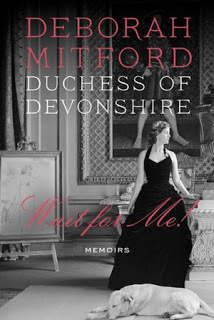
Now, most of my friends are not quite duchesses (more like countesses and baronesses, don't cha know?), but Debo's breezy style just feels like an old pal has been telling me about her very long and full life. Don't all of your friends cavort with Prince Charles, care for many of the Chatsworth Estate affairs, and feed their chickens? Actually, I really do have a few friends who feed their chickens, come to think of it. And Kristine waved at Prince Charles once as he passed her in his limo.
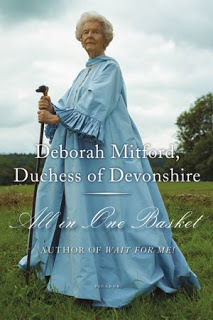
All in One Basket (immediately above) combines two of the Duchess's previous memoirs into one volume. They were entitled Counting My Chickens and Home to Roost, collections of stories and essays she wrote earlier. Wait For Me (top picture) is a memoir of her childhood and marriage to nearly the present.
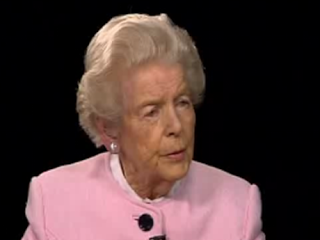 The dowager Duchess speaking to Charlie Rose
The dowager Duchess speaking to Charlie Rose
At the age of 92, she is living near Chatsworth in a house she redecorated -- with a few spare pieces from the Chatsworth attics -- after the death of her husband, the 11th Duke of Devonshire, in 2004, Chatsworth became the home of her son Peregrine Cavendish, known as Stoker, 12th Duke of Devonshire. and his wife Amanda, the Duchess.

The excellent website for Chatsworth is here. We've written about Chatsworth on this blog, as have many others. It is a favorite target of tourists and residents of the British Isles as well. The first time I visited Chatsworth, quite a few years ago, I was amazed to be greeted by flocks of chickens wandering the parking area.

These were not just ordinary chickens, but lovely exotic feathered works of art -- which walked around and seemed hungry. My suspicion is that the visitors frequently bring treats for the hens and roosters. When we entered the main house, the doorkeeper cautioned us not to let the creatures inside. "The Duchess," he said, "does not like her chickens in the house."
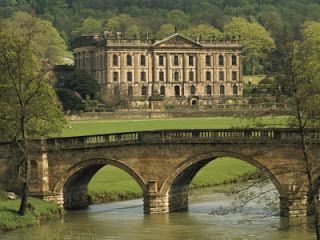
I have visited Chatsworth several times and I would love to go again. And again. It is the quintessential English Country House and has been in the forefront of developing the Stately Home Industry, if I dare to call it that. Debo would not approve. However, she has been an inspiration and a guiding force for the movement.
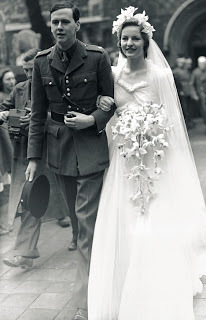 Deborah and Andrew at their wedding in 1941
Deborah and Andrew at their wedding in 1941
Deborah Vivien Freeman-Mitford was the youngest of the seven children of Lord Redesdale, thus one of the famous Mitford Sisters, of whom so much has been written. Nancy, eldest of the seven, wrote several novels which are very popular and have been turned into films or tv series; some of these have autobiographical overtones of the sisters' lives.
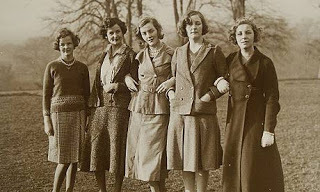
Jessica, is famous for her book The American Way of Death, criticising the funeral business. Two other sisters developed fascist sympathies, with Unity trying to shoot herself over the British declaration of war against Germany. Diana married the head of the British fascist party, Sir Oswald Moseley. Through it all, Debo ignored politics and remained devoted to each sister in her own way.
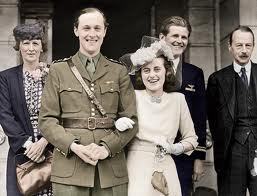 Marquess of Hartingdon and bride Kathleen Kennedy in 1944Joe Kennedy jr. stands behind his sister
Marquess of Hartingdon and bride Kathleen Kennedy in 1944Joe Kennedy jr. stands behind his sister
When Debo married Lord Andrew Cavendish in 1941, he was not expected to inherit the dukedom. But only four months after his elder brother William Cavendish, Marquess of Hartingdon married Kathleen Kennedy in May, 1944, the Marquess was killed in action in WWII. Kathleen, sister of future U. S. President John F. Kennedy, died in 1948 in a plane crash.
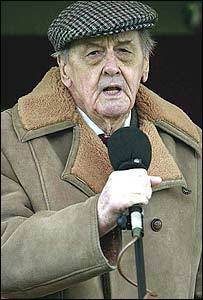 Andrew Cavendish, 11th Duke of Devonshire 1920-2004Picture: BBC
Andrew Cavendish, 11th Duke of Devonshire 1920-2004Picture: BBC
Thus Andrew and Debo had to prepare for their eventual roles as Duke and Duchess of Devonshire, along with all the responsibilities of many properties, tenants and enterprises. Andrew's father, the 10th Duke died in 1950. Though she writes with the advantage of hindsight, the reader of Debo's accounts can easily see what difficulties the family had with death duties and the establishment of Chatsworth as a profitable business capable of sustaining the house, its contents and activities for the public. Though she pooh-poohs the idea, Debo is largely responsible for Chatsworth's success. Thanks, Debo!
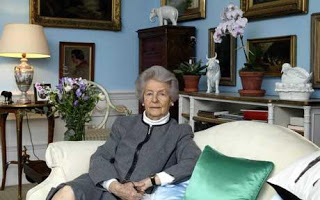 For a review of Wait For Me from the Telegraph, click here.
For a review of Wait For Me from the Telegraph, click here.
[image error]

Now, most of my friends are not quite duchesses (more like countesses and baronesses, don't cha know?), but Debo's breezy style just feels like an old pal has been telling me about her very long and full life. Don't all of your friends cavort with Prince Charles, care for many of the Chatsworth Estate affairs, and feed their chickens? Actually, I really do have a few friends who feed their chickens, come to think of it. And Kristine waved at Prince Charles once as he passed her in his limo.

All in One Basket (immediately above) combines two of the Duchess's previous memoirs into one volume. They were entitled Counting My Chickens and Home to Roost, collections of stories and essays she wrote earlier. Wait For Me (top picture) is a memoir of her childhood and marriage to nearly the present.
 The dowager Duchess speaking to Charlie Rose
The dowager Duchess speaking to Charlie RoseAt the age of 92, she is living near Chatsworth in a house she redecorated -- with a few spare pieces from the Chatsworth attics -- after the death of her husband, the 11th Duke of Devonshire, in 2004, Chatsworth became the home of her son Peregrine Cavendish, known as Stoker, 12th Duke of Devonshire. and his wife Amanda, the Duchess.

The excellent website for Chatsworth is here. We've written about Chatsworth on this blog, as have many others. It is a favorite target of tourists and residents of the British Isles as well. The first time I visited Chatsworth, quite a few years ago, I was amazed to be greeted by flocks of chickens wandering the parking area.

These were not just ordinary chickens, but lovely exotic feathered works of art -- which walked around and seemed hungry. My suspicion is that the visitors frequently bring treats for the hens and roosters. When we entered the main house, the doorkeeper cautioned us not to let the creatures inside. "The Duchess," he said, "does not like her chickens in the house."

I have visited Chatsworth several times and I would love to go again. And again. It is the quintessential English Country House and has been in the forefront of developing the Stately Home Industry, if I dare to call it that. Debo would not approve. However, she has been an inspiration and a guiding force for the movement.
 Deborah and Andrew at their wedding in 1941
Deborah and Andrew at their wedding in 1941Deborah Vivien Freeman-Mitford was the youngest of the seven children of Lord Redesdale, thus one of the famous Mitford Sisters, of whom so much has been written. Nancy, eldest of the seven, wrote several novels which are very popular and have been turned into films or tv series; some of these have autobiographical overtones of the sisters' lives.

Jessica, is famous for her book The American Way of Death, criticising the funeral business. Two other sisters developed fascist sympathies, with Unity trying to shoot herself over the British declaration of war against Germany. Diana married the head of the British fascist party, Sir Oswald Moseley. Through it all, Debo ignored politics and remained devoted to each sister in her own way.
 Marquess of Hartingdon and bride Kathleen Kennedy in 1944Joe Kennedy jr. stands behind his sister
Marquess of Hartingdon and bride Kathleen Kennedy in 1944Joe Kennedy jr. stands behind his sisterWhen Debo married Lord Andrew Cavendish in 1941, he was not expected to inherit the dukedom. But only four months after his elder brother William Cavendish, Marquess of Hartingdon married Kathleen Kennedy in May, 1944, the Marquess was killed in action in WWII. Kathleen, sister of future U. S. President John F. Kennedy, died in 1948 in a plane crash.
 Andrew Cavendish, 11th Duke of Devonshire 1920-2004Picture: BBC
Andrew Cavendish, 11th Duke of Devonshire 1920-2004Picture: BBCThus Andrew and Debo had to prepare for their eventual roles as Duke and Duchess of Devonshire, along with all the responsibilities of many properties, tenants and enterprises. Andrew's father, the 10th Duke died in 1950. Though she writes with the advantage of hindsight, the reader of Debo's accounts can easily see what difficulties the family had with death duties and the establishment of Chatsworth as a profitable business capable of sustaining the house, its contents and activities for the public. Though she pooh-poohs the idea, Debo is largely responsible for Chatsworth's success. Thanks, Debo!
 For a review of Wait For Me from the Telegraph, click here.
For a review of Wait For Me from the Telegraph, click here.[image error]
Published on September 12, 2012 01:00
September 10, 2012
A Couple In England - Free Airline Tickets?

You will no doubt recall how thrilled my husband was when I recently let him in on the fact that we'd be flying to England on Christmas Day. One of his first remarks, made just after, "Oh, eh?" was, "How much is this going to cost us?" "Hardly anything at all," I replied, content in the knowledge that I'd been passing every purchase I conceivably could through my American Airlines credit card.
Recently, I used all the Advantage Miles I'd accumulated in order to book tickets for our flights to England and used the miles for two tickets from Newark to London (I just missed out point-wise on two round trip tix). I figured I'd use cash and buy our return tickets later. When later came, I was shocked and dismayed to find that purchasing two one way tickets home would cost us three times what a round trip ticket would cost. Holy C@@P!!!!
To put it mildly, I had Royally Screwed Up. What to do? What to tell the Hubby, who lingers under the impression that I have everything to do with this trip under control? And that it's going to be relatively economical? I pondered this dilemma for days, all the while with Alec Baldwin's voice playing in my head as he laughed maniacally about `blackout dates' and the horrors of trying to use one's accumulated miles, much less rearranging them. I remembered every frequent flyer horror story every friend of mine had ever related.
I put off calling American Airlines for days, certain of the fact that no good at all would come from the call and that I would be left with no choice but to triple pay for our airfare. Finally, I worked up my courage and called. And an angel named Betty answered. And listened patiently to my panic stricken tale. And then undid and rearranged my previous travel arrangements, smoothed everything out and only charged me a $150.00 penalty to do so. And all without said Hubby finding out.
Oh, there was one hitch - those dreaded black out dates. It turns out that no frequent flyer seats were available for our planned return date, so now Hubby and I must make the supreme sacrifice and stay in England an extra day.
Betty, you are a star.
[image error]
Published on September 10, 2012 08:11
September 6, 2012
The Wellington Connection - Beer
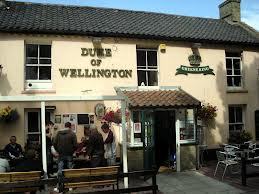 Once upon a time in England, an alehouse/tavern licence was very expensive and was based upon the size of the premises. Many who sought to open such an enterprise were financially prohibited from doing so until the Duke of Wellington's Beer House Act of 1830 changed the playing field dramatically. The Act reduced the licence fee to two guineas, permitting the sale of beer and cider only. The main object of the Act was to reduce the consumption of spirits, such as gin and other strong liquors.
Once upon a time in England, an alehouse/tavern licence was very expensive and was based upon the size of the premises. Many who sought to open such an enterprise were financially prohibited from doing so until the Duke of Wellington's Beer House Act of 1830 changed the playing field dramatically. The Act reduced the licence fee to two guineas, permitting the sale of beer and cider only. The main object of the Act was to reduce the consumption of spirits, such as gin and other strong liquors. As the website Exeter Memories tells us: "During the 18th-century, the production and consumption of gin exploded, especially amongst the poor, causing violence and misery for many. Government attempts to prohibit the production of gin with the Gin Act of 1736 had little effect. Distilling changed from straight gin to "medicinal" spirits to circumvent the Act, and fanciful names such as Cuckold’s Comfort and My Lady’s Eye Water were used to describe the new drinks.
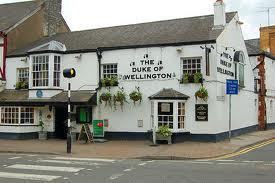
"The introduction of the Beer House Act of 1830 tried a different approach to reducing gin consumption and hence, public drunkenness. Anyone, on payment of 2 guineas to a magistrate could obtain a license to open a beer house. Permission was only granted for six days a week, with Sundays excepted. Only beer and cider could be sold.
"The result was a huge growth of beer houses and beer sellers, many from the front rooms of terrace houses and cottages. Another provision of the act was that existing taverns, inns and pubs could also brew their own beer on the premises. This had a knock effect, for there was a growth of demand for hops and barley for malting, thus bringing a new market for many farmers. Within eight years of the act being passed, 46,000 beer houses were opened, almost equalling the number of existing, pubs, taverns and inns."
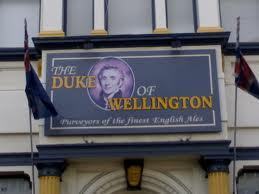
Midlands Pubs picks up the story from there - "Following the 1830 Act, beer production went through the roof. Large common brewers engaged travelling sales people to find new trading locations. These agents actively encouraged householders to open up a part of their property, usually the front parlour, in order to sell beer. They even offered to pay the two guinea licence on their behalf and would offer credit terms to their clients.
"Many of the new beer houses throughout the land named their pubs in honour of the Iron Duke. Their pub signs tended to display Wellington in his military roles and often celebrated his battle achievements that had captured the imagination of the public. However, more often than not, the new publicans were showing appreciation to the man who had helped them set up in business. Not all houses bought their beers from common brewers. Some chose to brew themselves whilst others employed a travelling brewer who would go from pub to pub producing the house ales.
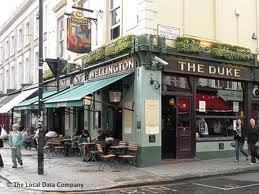
"Naturally, some beer houses were more successful than others. Those who gained a reputation for their ales enjoyed good trade. The licensee would often use the profits to buy the neighbouring cottage into which the family would move whilst the existing house was expanded. Indeed, there are some pubs that have expanded into a full row of a terrace, the rooms being used as separate bar, parlour, smoke room, lounge and family room. The early beer house movement was all very laissez-faire.
"Although many beer houses were eradicated under later legislation, many survived and evolved into fully licensed premises. Accordingly, in addition to beer and cider, they were allowed to sell wines and spirits. 1869 was a key cut-off point, after which it was not so easy to obtain a full licence. Indeed, the 1869 Wine and Beerhouse Act was designed to curtail the number of pubs that were opening around the country. However, pubs that had obtained licences before this date did have a degree of protection in terms of magisterial control.
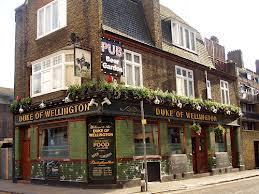
"Many houses that did not obtain a full licence managed to continue in business providing that the house conformed to all legislation and was kept orderly. These continued to simply sell beer and cider. For example, by 1890 almost half of Birmingham's 2,178 public houses were beer houses. In fact, beer houses continued up until the 1950's when finally a full licence was granted to those that had survived." The Duke of Wellington . . . what a guy! [image error]
Published on September 06, 2012 00:20
September 4, 2012
At Auction
As you may know, we love perusing auction catalogues and sighing over the fabulous items for sale. Canterbury Auction Galleries is holding a two day auction beginning today and below we show you just a few of the trinkets for sale.
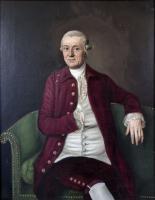
Lot 281After Johann Zoffany (1733-1810) - Oil painting - Three quarters length portrait of David Garrick seated and wearing a red frock coat, canvas 26ins x 21ins, in moulded gilt frame. Guide Price: £250-350
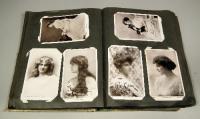
Lot 418A late Victorian early 20th Century postcard album containing primarily a group of topographical views, mostly British, and a ditto album containing a collection of "Beauties." Guide Price: £150-200
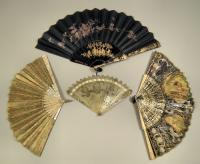 Lot 525A Chinese mother of pearl fan, the silk and gilt thread panel decorated in muted colours, 15ins (383mm) overall (19th Century - slight damage throughout), and three other fans, various. Guide Price: £150-200
Lot 525A Chinese mother of pearl fan, the silk and gilt thread panel decorated in muted colours, 15ins (383mm) overall (19th Century - slight damage throughout), and three other fans, various. Guide Price: £150-200
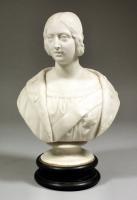 Lot 551A Copeland Parianware shoulder-length bust - Young Queen Victoria, published June 1st 1854, on separate stepped circular socle, 10.75ins high (impressed factory mark, signed names of sculptor and modeller, date 1853, and published date - some damage)
Lot 551A Copeland Parianware shoulder-length bust - Young Queen Victoria, published June 1st 1854, on separate stepped circular socle, 10.75ins high (impressed factory mark, signed names of sculptor and modeller, date 1853, and published date - some damage)
Guide Price: £100-150 Lot 607A Victorian "Bristol Blue" rolling pin printed and overpainted with nautical themes,and a central floral and leaf cartouche containing a sentimental verse, 17.5ins long, and one smaller ditto, 15ins long (worn). Guide Price: £80-120
Lot 607A Victorian "Bristol Blue" rolling pin printed and overpainted with nautical themes,and a central floral and leaf cartouche containing a sentimental verse, 17.5ins long, and one smaller ditto, 15ins long (worn). Guide Price: £80-120
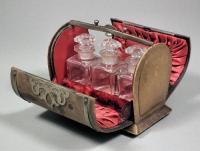 Lot 627A Victorian brown leather and plated mounted domed top scent casket, the folding sides opening to reveal red silk lined three division interior, 5.5ins x 3ins x 4ins high (faded and worn), with three conforming cut-glass rectangular scent bottles for same.
Lot 627A Victorian brown leather and plated mounted domed top scent casket, the folding sides opening to reveal red silk lined three division interior, 5.5ins x 3ins x 4ins high (faded and worn), with three conforming cut-glass rectangular scent bottles for same.
Guide Price: £70-100
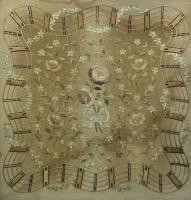 Lot 657A late Georgian silk needlework panel worked in coloured silks with floral sprays within a stylised sinuous five bar fence border, 17.5ins x 17ins, in walnut frame and glazed. Guide Price: £80-120
Lot 657A late Georgian silk needlework panel worked in coloured silks with floral sprays within a stylised sinuous five bar fence border, 17.5ins x 17ins, in walnut frame and glazed. Guide Price: £80-120
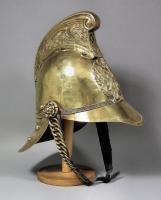
Lot 735An Edwardian Merryweather pattern brass fireman's helmet with original leather liner and brass link chain. Guide Price: £300-400
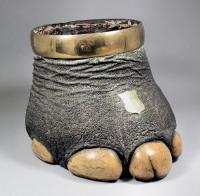 Lot 761A late 19th Century Indian elephant's foot with brass mounted rim (to form a jardiniere/waste paper bin), the plated shield pattern plaque to front worded "Chittagong Hills" and dated 1898, 13.5ins high. Guide Price: £200-300
Lot 761A late 19th Century Indian elephant's foot with brass mounted rim (to form a jardiniere/waste paper bin), the plated shield pattern plaque to front worded "Chittagong Hills" and dated 1898, 13.5ins high. Guide Price: £200-300
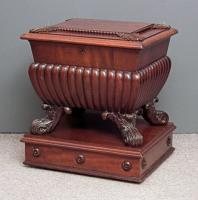 Lot 1027A William IV mahogany rectangular wine cooler of Irish design, the stepped top with leaf carving and bead moulding enclosing fitted interior and with gadrooned angled sides, on carved and scrolled paw feet, and plinth base, 27ins wide x 23ins deep x 29ins high, with key for same. Guide Price: £2000-3000
Lot 1027A William IV mahogany rectangular wine cooler of Irish design, the stepped top with leaf carving and bead moulding enclosing fitted interior and with gadrooned angled sides, on carved and scrolled paw feet, and plinth base, 27ins wide x 23ins deep x 29ins high, with key for same. Guide Price: £2000-3000
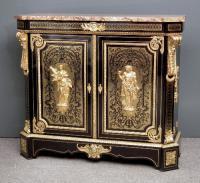 Lot 1125A 19th Century French ormolu mounted and contra Boulle ebonised pier cabinet, with red veined marble slab to top, the canted front corners with scrolled mounts, the mahogany lined interior fitted two shelves enclosed by a pair of doors with ormolu mounts representing Bacchus and Ceres, on scrolled plinth base, 49ins wide x 19ins deep x 43ins high. Guide Price: £6000-8000
Lot 1125A 19th Century French ormolu mounted and contra Boulle ebonised pier cabinet, with red veined marble slab to top, the canted front corners with scrolled mounts, the mahogany lined interior fitted two shelves enclosed by a pair of doors with ormolu mounts representing Bacchus and Ceres, on scrolled plinth base, 49ins wide x 19ins deep x 43ins high. Guide Price: £6000-8000
[image error]

Lot 281After Johann Zoffany (1733-1810) - Oil painting - Three quarters length portrait of David Garrick seated and wearing a red frock coat, canvas 26ins x 21ins, in moulded gilt frame. Guide Price: £250-350

Lot 418A late Victorian early 20th Century postcard album containing primarily a group of topographical views, mostly British, and a ditto album containing a collection of "Beauties." Guide Price: £150-200
 Lot 525A Chinese mother of pearl fan, the silk and gilt thread panel decorated in muted colours, 15ins (383mm) overall (19th Century - slight damage throughout), and three other fans, various. Guide Price: £150-200
Lot 525A Chinese mother of pearl fan, the silk and gilt thread panel decorated in muted colours, 15ins (383mm) overall (19th Century - slight damage throughout), and three other fans, various. Guide Price: £150-200 Lot 551A Copeland Parianware shoulder-length bust - Young Queen Victoria, published June 1st 1854, on separate stepped circular socle, 10.75ins high (impressed factory mark, signed names of sculptor and modeller, date 1853, and published date - some damage)
Lot 551A Copeland Parianware shoulder-length bust - Young Queen Victoria, published June 1st 1854, on separate stepped circular socle, 10.75ins high (impressed factory mark, signed names of sculptor and modeller, date 1853, and published date - some damage)Guide Price: £100-150
 Lot 607A Victorian "Bristol Blue" rolling pin printed and overpainted with nautical themes,and a central floral and leaf cartouche containing a sentimental verse, 17.5ins long, and one smaller ditto, 15ins long (worn). Guide Price: £80-120
Lot 607A Victorian "Bristol Blue" rolling pin printed and overpainted with nautical themes,and a central floral and leaf cartouche containing a sentimental verse, 17.5ins long, and one smaller ditto, 15ins long (worn). Guide Price: £80-120 Lot 627A Victorian brown leather and plated mounted domed top scent casket, the folding sides opening to reveal red silk lined three division interior, 5.5ins x 3ins x 4ins high (faded and worn), with three conforming cut-glass rectangular scent bottles for same.
Lot 627A Victorian brown leather and plated mounted domed top scent casket, the folding sides opening to reveal red silk lined three division interior, 5.5ins x 3ins x 4ins high (faded and worn), with three conforming cut-glass rectangular scent bottles for same.Guide Price: £70-100
 Lot 657A late Georgian silk needlework panel worked in coloured silks with floral sprays within a stylised sinuous five bar fence border, 17.5ins x 17ins, in walnut frame and glazed. Guide Price: £80-120
Lot 657A late Georgian silk needlework panel worked in coloured silks with floral sprays within a stylised sinuous five bar fence border, 17.5ins x 17ins, in walnut frame and glazed. Guide Price: £80-120
Lot 735An Edwardian Merryweather pattern brass fireman's helmet with original leather liner and brass link chain. Guide Price: £300-400
 Lot 761A late 19th Century Indian elephant's foot with brass mounted rim (to form a jardiniere/waste paper bin), the plated shield pattern plaque to front worded "Chittagong Hills" and dated 1898, 13.5ins high. Guide Price: £200-300
Lot 761A late 19th Century Indian elephant's foot with brass mounted rim (to form a jardiniere/waste paper bin), the plated shield pattern plaque to front worded "Chittagong Hills" and dated 1898, 13.5ins high. Guide Price: £200-300 Lot 1027A William IV mahogany rectangular wine cooler of Irish design, the stepped top with leaf carving and bead moulding enclosing fitted interior and with gadrooned angled sides, on carved and scrolled paw feet, and plinth base, 27ins wide x 23ins deep x 29ins high, with key for same. Guide Price: £2000-3000
Lot 1027A William IV mahogany rectangular wine cooler of Irish design, the stepped top with leaf carving and bead moulding enclosing fitted interior and with gadrooned angled sides, on carved and scrolled paw feet, and plinth base, 27ins wide x 23ins deep x 29ins high, with key for same. Guide Price: £2000-3000 Lot 1125A 19th Century French ormolu mounted and contra Boulle ebonised pier cabinet, with red veined marble slab to top, the canted front corners with scrolled mounts, the mahogany lined interior fitted two shelves enclosed by a pair of doors with ormolu mounts representing Bacchus and Ceres, on scrolled plinth base, 49ins wide x 19ins deep x 43ins high. Guide Price: £6000-8000
Lot 1125A 19th Century French ormolu mounted and contra Boulle ebonised pier cabinet, with red veined marble slab to top, the canted front corners with scrolled mounts, the mahogany lined interior fitted two shelves enclosed by a pair of doors with ormolu mounts representing Bacchus and Ceres, on scrolled plinth base, 49ins wide x 19ins deep x 43ins high. Guide Price: £6000-8000[image error]
Published on September 04, 2012 00:35
September 1, 2012
More Interesting Apps
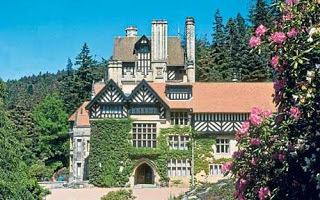
Recently, we've run across two great apps with a common theme - historic houses. Both look fun, not to mention quite useful.
The Historic Houses Association new iPhone and iPad app allows you to find an event, search for a property to visit or browse images. The Historic Houses Association (HHA) represents hundreds of privately-owned properties: from ancient castles and opulent palaces to quirky medieval manor houses or elegant Elizabethan mansions. Most have glorious gardens for you to enjoy and many have wonderful restaurants or tea rooms to refresh you after a few hours exploring. Others have even more to offer, from adventure playgrounds and galleries to mini railways and safari parks.
Features of the App include:
•Find a property near you or search the map to plan your trip. Details include photo, description, address, contact details and opening times
•Find out about all the latest events
•Save properties and events to your favourites so you can quickly go back to them
•Browse a gallery of stunning images to inspire you and find out about each property
•Share images and property details with your friends
•Find out about the HHA, read some facts and figures, or become a Friend and visit hundreds of houses and gardens free

This application will not only map out the most famous film scenes around your location, but it will allow you to browse famous Hollywood and Independent films that have been shot here so you can discover an entire Great British film tour whether you’re looking for Harry Potter’s Hogwarts, or Batman’s Wayne Manor. Each film is accompanied by a detailed synopsis and list of locations, each of which has its own description, map entry, and many locations have photos included. Take your own photos in the ‘My gallery’ section, automatically tag them with your location address, and post them to your Facebook wall with just one tap. You can purchase the app here.
[image error]
Published on September 01, 2012 23:56
August 30, 2012
Swimming in August
Summer is ending for another year and soon Victoria will lament the closing of the Regency House swimming pool until next May. Sigh. Of course, I will be in Florida by mid January, ready for another pool -- and the lovely beaches too.
Sea Bathing became increasingly fashionable in the 18th century as doctors praised the beneficial effects of drinking sea water and bathing in the cold salt-water of the Channel, or the North or Irish Sea.
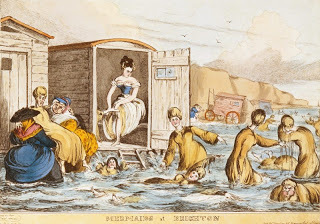
The print above, by William Heath (1795-1840), ca. 1829, depicts the Mermaids of Brighton near their bathing machines. On the left two sturdy dippers, as the women who assisted the bathers were called, help a girl in a sort of loose garment like a shift (or a shroud???). Inside the wooden structure, another young lady begins to disrobe, while others cavort in the water. How very different than the look below, the Italian swimming star in the London Olympics, Federica Pellegrini.

But apparently, not all sea bathers were clothed at all! The caricature below by Thomas Rowlandson (1776-1827) is entitled Summer Amusement at Margate, or a Peep at the Mermaids and clearly shows a group of men oogling the nude bathers.
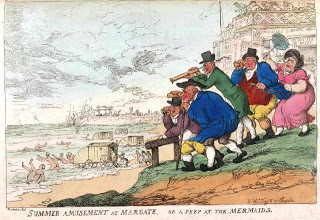
Even more revealing is Rowlandson's Venus Bathing (Margate): A Fashionable Dip. Margate is in Kent.
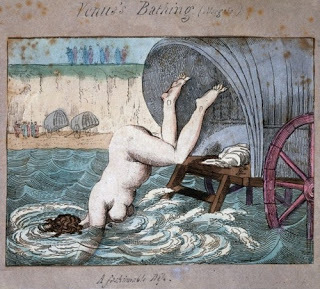
And its companion engraving by Rowlandson, Sideway or any way, in which a crowd seems to have gathered at the top of the cliff to observe:
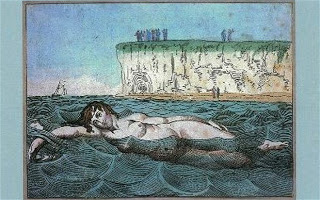
Most fashion plates from the early 19th century show ladies dressed quite properly indeed. Below, From Ackermann's Repository, 1809:
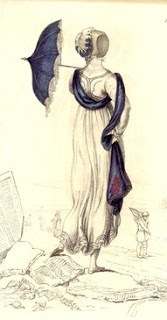
La Belle Assemblee chose this costume for sea bathing in 1815. Note the bathing machines in the background, lower right:
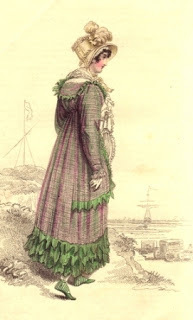
The Bathing Machines were built to various designs, but most had an enclosed room on high wheels in which one could dress and undress. The vehicles were pulled out into the water by horses, donkeys or even humans. Many had large canvas awnings which could be lowered for privacy. The bather enters the water via steps and may be assisted by a helper, the dipper, as seen in the first engraving above.
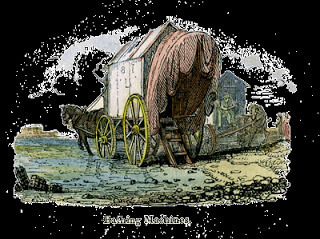
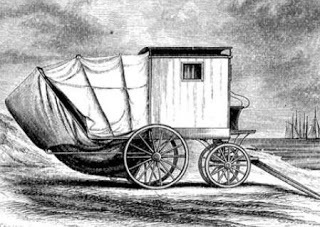 Another Version
Another Version
One of the dippers, Martha Gunn, became famous in Brighton, a favorite of the Prince of Wales, and became an advertisement for the resort itself. Her portrayal below shows her importance as she wears the Prince's three feathers on her hat.
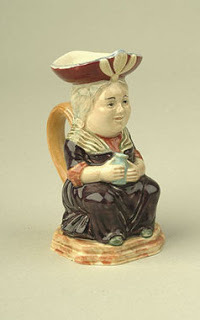 Toby jug, Mrs. Gunn
Toby jug, Mrs. Gunn
In 1773, author Frances (Fanny) Burney (1753-1840) recorded her experience while sea bathing.
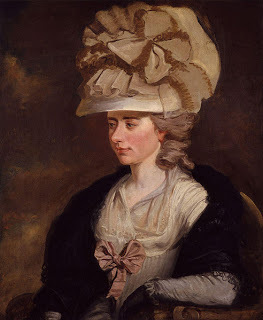 Fanny Burney by Edward Francis Burney, c. 1784National Portrait Gallery, London
Fanny Burney by Edward Francis Burney, c. 1784National Portrait Gallery, London
August 1773
"Ever since I went to Torbay, I have been tormented with a dreadful cold and very much advised to sea bathing in order to harden me…. I was terribly frightened, and really thought I should never have recovered from the plunge. I had not breath enough to speak for a minute or two, the shock was beyond expression; but after I got back to the [bathing] machine, I presently felt myself in a glow that was delightful – it is the finest feeling in the world, and will induce me to bathe as often as will be safe. "
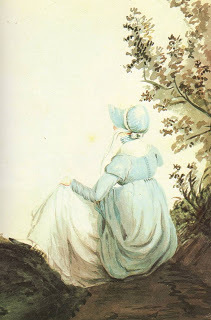 Jane Austen, watercolour by her sister Cassandra
Jane Austen, watercolour by her sister Cassandra
Jane Austen too indulged in sea bathing. Her family often visited coastal resorts. She wrote to Cassandra from Lyme:
Friday 14 September 1804
"...I continue quite well, in proof of which I have bathed again this morning. It was absolutely necessary that I should have the little fever and indisposition, which I had;--it has been all the fashion this week in Lyme..."
That evening, she added, "...The Bathing was so delightful this morning and Molly so pressing with me to enjoy myself that I believe I staid in rather too long, as since the middle of the day I have felt unreasonably tired. I shall be more careful another time, and shall not bathe tomorrow, as I had before intended...
I think the former quote shows Jane Austen's ironic wit, but her later remarks sound quite sincere!
I hope you have time, if you wish, for a few more dips in the sea or the pool this season.
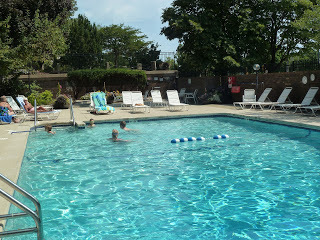 The pool at Victoria's Building[image error]
The pool at Victoria's Building[image error]
Sea Bathing became increasingly fashionable in the 18th century as doctors praised the beneficial effects of drinking sea water and bathing in the cold salt-water of the Channel, or the North or Irish Sea.

The print above, by William Heath (1795-1840), ca. 1829, depicts the Mermaids of Brighton near their bathing machines. On the left two sturdy dippers, as the women who assisted the bathers were called, help a girl in a sort of loose garment like a shift (or a shroud???). Inside the wooden structure, another young lady begins to disrobe, while others cavort in the water. How very different than the look below, the Italian swimming star in the London Olympics, Federica Pellegrini.

But apparently, not all sea bathers were clothed at all! The caricature below by Thomas Rowlandson (1776-1827) is entitled Summer Amusement at Margate, or a Peep at the Mermaids and clearly shows a group of men oogling the nude bathers.

Even more revealing is Rowlandson's Venus Bathing (Margate): A Fashionable Dip. Margate is in Kent.

And its companion engraving by Rowlandson, Sideway or any way, in which a crowd seems to have gathered at the top of the cliff to observe:

Most fashion plates from the early 19th century show ladies dressed quite properly indeed. Below, From Ackermann's Repository, 1809:

La Belle Assemblee chose this costume for sea bathing in 1815. Note the bathing machines in the background, lower right:

The Bathing Machines were built to various designs, but most had an enclosed room on high wheels in which one could dress and undress. The vehicles were pulled out into the water by horses, donkeys or even humans. Many had large canvas awnings which could be lowered for privacy. The bather enters the water via steps and may be assisted by a helper, the dipper, as seen in the first engraving above.

 Another Version
Another VersionOne of the dippers, Martha Gunn, became famous in Brighton, a favorite of the Prince of Wales, and became an advertisement for the resort itself. Her portrayal below shows her importance as she wears the Prince's three feathers on her hat.
 Toby jug, Mrs. Gunn
Toby jug, Mrs. GunnIn 1773, author Frances (Fanny) Burney (1753-1840) recorded her experience while sea bathing.
 Fanny Burney by Edward Francis Burney, c. 1784National Portrait Gallery, London
Fanny Burney by Edward Francis Burney, c. 1784National Portrait Gallery, LondonAugust 1773
"Ever since I went to Torbay, I have been tormented with a dreadful cold and very much advised to sea bathing in order to harden me…. I was terribly frightened, and really thought I should never have recovered from the plunge. I had not breath enough to speak for a minute or two, the shock was beyond expression; but after I got back to the [bathing] machine, I presently felt myself in a glow that was delightful – it is the finest feeling in the world, and will induce me to bathe as often as will be safe. "
 Jane Austen, watercolour by her sister Cassandra
Jane Austen, watercolour by her sister CassandraJane Austen too indulged in sea bathing. Her family often visited coastal resorts. She wrote to Cassandra from Lyme:
Friday 14 September 1804
"...I continue quite well, in proof of which I have bathed again this morning. It was absolutely necessary that I should have the little fever and indisposition, which I had;--it has been all the fashion this week in Lyme..."
That evening, she added, "...The Bathing was so delightful this morning and Molly so pressing with me to enjoy myself that I believe I staid in rather too long, as since the middle of the day I have felt unreasonably tired. I shall be more careful another time, and shall not bathe tomorrow, as I had before intended...
I think the former quote shows Jane Austen's ironic wit, but her later remarks sound quite sincere!
I hope you have time, if you wish, for a few more dips in the sea or the pool this season.
 The pool at Victoria's Building[image error]
The pool at Victoria's Building[image error]
Published on August 30, 2012 01:00
August 28, 2012
Dickens: Bicentenary of his birth
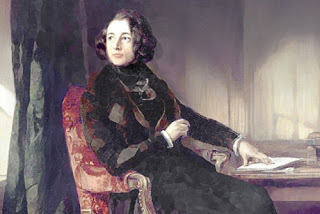 Charles Dickens (1812-1870), painted by Daniel Maclise (1806-1870)
Charles Dickens (1812-1870), painted by Daniel Maclise (1806-1870)Victoria here, reporting on my latest encounters with a favorite author of mine, Charles Dickens. My local PBS station is rerunning the presentation of Oliver Twist and Great Expectations they first showed last winter. I hope you have a chance to see them too.
 Oliver Twist, played by William Miller
Oliver Twist, played by William MillerThe PBS website, here, has lots of details about the BBC-Masterpiece production of Oliver Twist, including a synopsis, cast information and a Dickens timeline.

You can buy this DVD, as well as many other classics here.
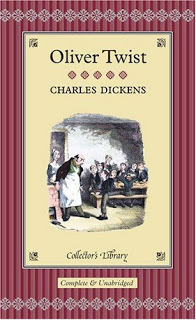
I have to admit I remember the story from several of the dozens of films and television series rather than from the book, which I probably read in high school. There have been many stage versions as well, including the very popular London production of Oliver, the Musical in 1960.
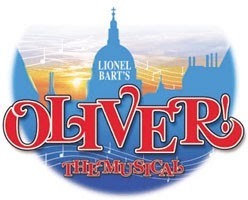
The musical also ran on Broadway for a long time, and has been successfully revived in Britain and the U.S. several times. The film version won the Academy Award for Best Picture in 1969.
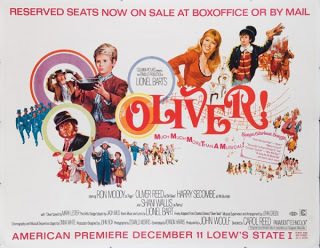
I think the reason for the enduring popularity of the story is mainly attributable to the wonderful characters, the innocent young Oliver, the unforgettable Fagin, Artful Dodger, Nancy, and Bill Sikes -- and the family that ultimately rescues Oliver and brings a happy ending. As in all of Dickens, the details of the London scene are unmatched.
Personally, I prefer Oliver Twist to Great Expectations, probably because Miss Havisham meets such a tragic ending in the latter. But nevertheless I will watch it. Again and again. Like Oliver Twist's, Pip's story has been filmed many times, from silent movies to current miniseries, and has been adapted for stage as well.
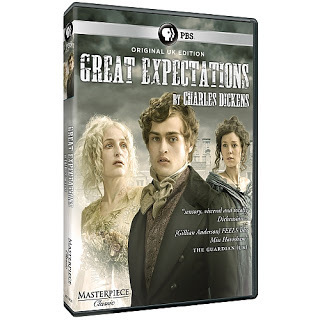
One of the book groups I participate in is reading A Tale of Two Cities, another Dickens novel that has been often adapted. "It was the best of times; it was the worst of times" has to be one of the most famous opening lines in English literature.
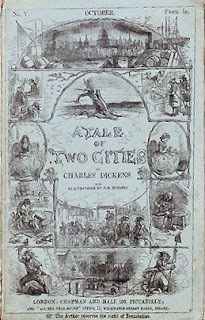 A Tale of Two Cities, published 1859
A Tale of Two Cities, published 1859And to top off my Year of Dickens, I am reading Claire Tomalin's biography Charles Dickens, published in 2011. Like her previous biographies of Jane Austen, Samuel Pepys and others, this account is eminently readable. She deals with complex personalities in a realistic and engaging way.
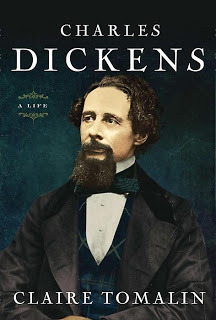
I hope you are having your own Dickens Year in 2012...if not, you still have time!
[image error]
Published on August 28, 2012 01:00
August 26, 2012
Rowland Hill's Hawkstone Hall For Sale
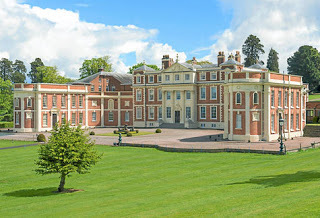
A historic mansion house in Shropshire has gone on the market for £5 million, and is looking for just its fourth new owner in more than 550 years. The 80-room Hawkstone Hall, in Marchamley, near Wem, is the former home of the Hill family – including Rowland Hill, who was the Duke of Wellington’s deputy at the Battle of Waterloo.
** Lord Rowland Hill was no relation to Sir Rowland Hill, inventor of the postage stamp.
Peter Duckers is the curator at the Shropshire Regimental Museum, based in Shrewsbury Castle. He is a great admirer of Lord Hill: "He was known as Daddy Hill to his men because he was one of the few generals who took a serious interest in the welfare of the men under him."
At Waterloo, Lord Hill commanded the 2nd Army Corps which included the 2nd and 4th divisions: "There were some of the very finest of the British Army's regiments in it, including veterans of the Peninsular War.
"He took part in the overall command of what was one of the greatest military victories in British history."
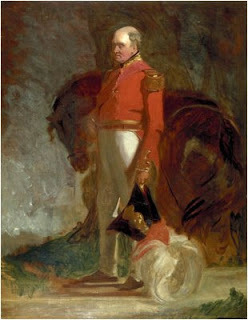
In 1817, General Sir Rowland Hill (above) became Colonel of the 53rd Shropshire Regiment. He was also MP for Shrewsbury from 1812-1814. At the Battle of Waterloo Hill commanded the 2nd Corps. He led the famous charge of Sir Frederick Adam's brigade against the Imperial Guard towards the end of the battle. For some time it was thought that he had fallen in the melee. He escaped, however, without a wound and continued with the army in France until its withdrawal in 1818.
On the 27 August 1815 the Dutch King William I made him a Commander of the exclusive Military Order of William. He succeeded the Duke of Wellington as Commander-in-Chief of the Forces in 1828 and served in this capacity until 1839.
He lived at Hardwick Grange at Hadnall and it was there that he died on December 10 1842, aged 71, just after he had been made a Viscount. He was buried at Hadnall Church.
For the last 85 years, Hawkstone Hall has been used as an educational institution and is now a retreat centre. The current owners, a Roman Catholic missionary congregation called The Redemptorists, have decided to sell.
Nigel Grugeon, from estate agent Reeves and Partners who are selling the property, said it would "attract international attention." "It is rare to deal with a property which has had so few owners down the centuries and it does bring us a sense of responsibility," he said.
The Hawkstone estate was owned by the Hill family from 1556 to 1906. By the end of the 19th Century the family were bankrupt and the contents of the hall were sold. The Roman Catholic Redemptorists bought it for £10,000 in 1926 as a seminary to train priests. In the 1970s, the hall was turned into a pastoral centre and people come from across the world to attend a variety of courses and conferences.
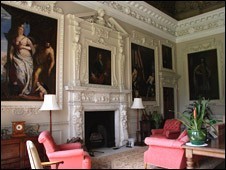
Description:
The Original Hall
A Listed Georgian mansion dating from circa 1700 is built over three floors with a cellar beneath. The gross internal floor area (GIA) is approximately 20,500 sq ft (1,900 sq m) excluding the cellar. On the ground floor there is an impressive entrance hallway and six reception rooms including the magnificent ballroom and Venetian saloon with a wealth of architectural and artistic features including many inset wall paintings.
The north wing contains two offices and the library, with a small gymnasium in the basement whilst the south wing contains the 'Winter Garden', a TV room at a lower level and the immensely impressive 'Academy' above.
On the first floor there are four bedrooms, some with en suite facilities, a staff room with kitchenette and WC, an office, laundry room and ancillary facilities, with two further bedrooms and a seminar room on the first floor of the north wing. The second floor provides a further eight rooms, some used as bedrooms and some for study, with further bathrooms and WC facilities, and attic storage space above.
Historical Note
The Estate originally formed part of a Manor acquired by Sir Roland Hill MP in 1556 and remained the seat of the Hill family for almost 350 years. Hawkstone Hall is understood to date from circa 1700 with subsequent alterations between 1719 and 1725. There was then more substantial remodelling and enlargement in 1750.
The original Estate of the Hill family was broken up by 1906 when Hawkstone Hall was sold to the Liberal politician George Whiteley, later Lord Marchamley. He renovated the Hall and reduced the original wings in length. Following his death the property was acquired by the Roman Catholic Redemptorist Congregation of priests and brothers in 1926 and was originally occupied as a seminary. Since 1973/4 it has been run as an International Pastoral and Retreat Centre with associated conference facilities and residential accommodation.
The Residential Wing
Approximately 19,250 sq ft GIA (1,790 sq m) built in the 1960s and spread over three floors, there are circa 50 single bedrooms with extensive bathroom, WC and service accommodation.
The Estate
Extending to about 88 acres (35.6 Ha) in total, the Estate includes circa 63 acres (25.49 Ha) of agricultural land. The balance of about 25 acres (10.12 Ha) comprises the buildings with their adjoining landscaped gardens and woodland, and includes a former walled kitchen garden of approximately 2 acres (0.81 Ha) along with the two cottages and their gardens.
St Martin's & St Clement's Cottages
A pair of semi detached cottages adjoining the northern boundary of the Estate each with two reception rooms, a kitchen, three bedrooms and a bathroom. Separate sales particulars of the cottages are available on request.
The Chapel
Built in the mid 1930s in Romanesque style the Chapel is about 3,650 sq ft GIA (340 sq m) and has the capacity to seat approximately 150 people.
Interested parties should contact Reeves & Partners, Estate Agents. [image error]
Published on August 26, 2012 00:21
Kristine Hughes's Blog
- Kristine Hughes's profile
- 6 followers
Kristine Hughes isn't a Goodreads Author
(yet),
but they
do have a blog,
so here are some recent posts imported from
their feed.



